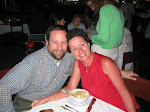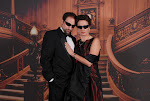Shortly after arriving in the United States, my parents were married in a local St. Louis Hungarian church, my mother 23 and my father 21 years of age. (It’s hard to imagine that two of my stepchildren are the same ages now…but I digress :)…)
Life was not easy and they lived in humble conditions at best. After the day’s work was done, there were night classes to learn English. 6 people were crammed into a 5-room flat in South St. Louis, and no doubt tensions ran high as the stress of living in a new country, with virtually no possessions, very little language, and even littler money weighed heavily on all of them.
My father wanted to try his hand in New York City, where the opportunities were big -- like the city’s “Big Apple” moniker. My mother had a hard time cutting the apron strings; it was the first time she was away from her family and being in a new country made it even tougher. She and my father often fought and their young marriage suffered. To complicate matters, I came along in 1964 – unexpectedly; there was no celebration over the beginning of new life. In fact when my mother told my father she was pregnant, they just stared at each other, shocked, and not in a good way.
Having a child did nothing to resolve issues between them. They divorced shortly after I was born, not able to reconcile differences at opposite ends of the spectrum.
Their divorce was extreme even by 1960s standards. “Shared Custody” was non-existent and things like child support and alimony were rarely enforced, mostly due to a lack of proper systems in place to monitor payments. If one was to parcel out blame to the “guilty parties” there was plenty of it to go around. For various reasons, my father didn’t meet alimony obligations assigned to him by the state, but neither did my mother allow me to visit him as she should have – she was incredibly bitter and resentful over the divorce and her emotions reigned supreme over sound judgment that a child needs to see and be loved by both of their parents, no matter the circumstances between them other than endangering the child’s safety.
I didn’t see my dad again until shortly before my mother’s death in 1980 – a full 13 years after their divorce, unreal by today’s standards. In that time my mother (and grandmother) filled my head with all sorts of ideas – all of them bad -- about my father. When I got older I found out some of them were true, but it wasn’t until I was out of college and well into adulthood that I also found out how much he loved me. For the first time I got to hear his side of their sad history, and it was a powerful lesson that there are ALWAYS two sides to every story. I also came to appreciate how difficult life was for him – he himself wasn’t raised by model parents either. I met my paternal grandmother only once when she came from Hungary to visit America. She treated my father as if he was still a child; she even remarked that only after meeting his grown daughter could she begin to comprehend her own son as an adult.
Once I finished college, I worked like a dog to obtain an MBA before I was 25. I made barely enough to pay the bills but I was employed by the University and had free tuition for my entire graduate school years; it was a worthwhile investment to live on macaroni and cheese in exchange for financial freedom down the road :).
And it paid off – my income rose just fine through the years. I began to wonder how I could “give something back.” A lot of people offered me good advice through the years, and there was no shortage of young people who were motivated but lacked financial resources.
I thought about instituting a scholarship at my former high school but didn’t want to appear like I was showing off. When talking to my dad about it, he said “Why are you concerned about what other people think? You should be thinking about the example you’re setting for other people. Imagine how others might be inspired to do something if you do…” I could hardly believe the words were coming from my father??? He was happy to get cigarettes and Dewar’s for half price at the Dirt Cheap store…and here he was waxing philanthropic to his daughter!
I put the scholarship in place – full tuition for a student who demonstrated equal levels of financial need and academic excellence. Another one followed – this one to the elementary school attached to our church. Then a capital building fund was put in place at our church for connecting all of our buildings together; we joyfully gave to that as well – more than twice what I earned with my first job out of school. We made ends meet just fine and I was amazed at how much joy I got from giving away something I had almost none of while growing up. Later on, my passion for triathlon would expand to benefit the homeless – our “Race for Reynosa” fundraiser was born to help build homes for the poor in Mexico. To date we’ve raised over $40,000 which has enabled us to build more than 20 new homes for families who otherwise sleep in shanties made of construction debris and other trash.
Today we contribute nearly a third of what we earn annually and it all goes to making a difference in the lives of others – PEOPLE are the only thing we take with us when we meet our Maker. Don Henley, lead vocalist for the group The Eagles, in his song Gimme What You Got, says “…you don’t see no hearses with luggage racks…” People are the ultimate eternal investment, not our houses, cars, jobs, or other toys.
Never underestimate the difference you can make in the life of someone else. Often it comes from the least expected place – but that’s the way God works sometimes. He’s in the business of surprising us. The problem is that we think small – our desires, our views, our goals – all small by His standards. One visit to Alaska will show you a glimpse into how big He thinks – imagine the Alaska Range as just the bottom step to His front porch. That’s a good start.
Thanks Dad for teaching me how to think BIG :).






